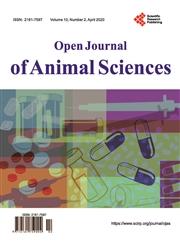Effects of Supplementing Finger Millet (Eleucine coracana) Straw with Grass Pea (Lathyrus sativus L.) Hulls and Concentrate Mixture on Feed Intake, Digestibility and Body Weight Change in Washera Sheep
引用次数: 1
Abstract
The productivity of sheep in Ethiopia is very low mainly due to a serious shortage of feedstuff. As a result, it is necessary to look for cheap locally available feedstuffs to sustain sheep production in the country. Non-conventional feeds like grass pea (Lathyrus sativus L.) hulls (GPH) could partly fill the gap in the feed supply, decrease competition for food between humans and animals and reduce feed cost. Therefore, this experiment was designed to evaluate effects of different proportions of grass pea hulls and concentrate mixture (CM) supplementation on feed intake, digestibility, and growth of Washera sheep fed finger millet straw (FMS) as a basal diet. Diets consisted FMS alone fed ad libitum (T1), 100% CM (T2), 30% GPH mixed with 70% CM (T3), 30% CM mixed with 70% GPH (T4), and 100% GPH (T5). For all treatments, FMS was fed ad libitum. Experimental sheep were arranged in a randomized complete block design and treatment feeds were assigned to the animals within a block. The results showed that FMS contained 5.5% CP and 68.9% NDF. there was reduction (p < 0.05) in DM intake, DM and CP digestibility and consequently depressed ADG in sheep. Partial budget analysis results showed that net return and change in net return were in the order of T3 > T2 > T4 > T5. Therefore, from biological point of view as well as based on partial budget analysis, T3 was found to be recommendable for smallholder sheep produc-ers.草豆(Lathyrus sativus L.)补充谷子(Eleucine coracana)秸秆的效果皮料和精料混合料对水洗羊采食量、消化率和体重变化的影响
埃塞俄比亚的绵羊产量非常低,主要是由于饲料严重短缺。因此,有必要寻找当地可获得的廉价饲料来维持该国的绵羊生产。草豆(Lathyrus sativus L.)壳(GPH)等非传统饲料可以部分填补饲料供应缺口,减少人与动物之间的食物竞争,降低饲料成本。因此,本试验旨在研究在基础饲粮中添加不同比例的豆荚壳与精料混合物(CM)对沃什拉羊采食量、消化率和生长的影响。饲粮分别为:单采枸杞(T1)、100%枸杞(T2)、30%枸杞与70%枸杞混合(T3)、30%枸杞与70%枸杞混合(T4)、100%枸杞(T5)。在所有处理中,FMS是自由喂养的。试验羊采用完全随机区组设计,在一个区组内分配处理饲料。结果表明,FMS中CP含量为5.5%,NDF含量为68.9%。绵羊的干物质采食量、干物质和粗蛋白质消化率降低(p < 0.05),从而降低日增重。部分预算分析结果显示,净收益和净收益变化的顺序为T3 > T2 > T4 > T5。因此,从生物学角度和部分预算分析来看,T3是小农羊养殖户的推荐品种。
本文章由计算机程序翻译,如有差异,请以英文原文为准。
求助全文
约1分钟内获得全文
求助全文

 求助内容:
求助内容: 应助结果提醒方式:
应助结果提醒方式:


